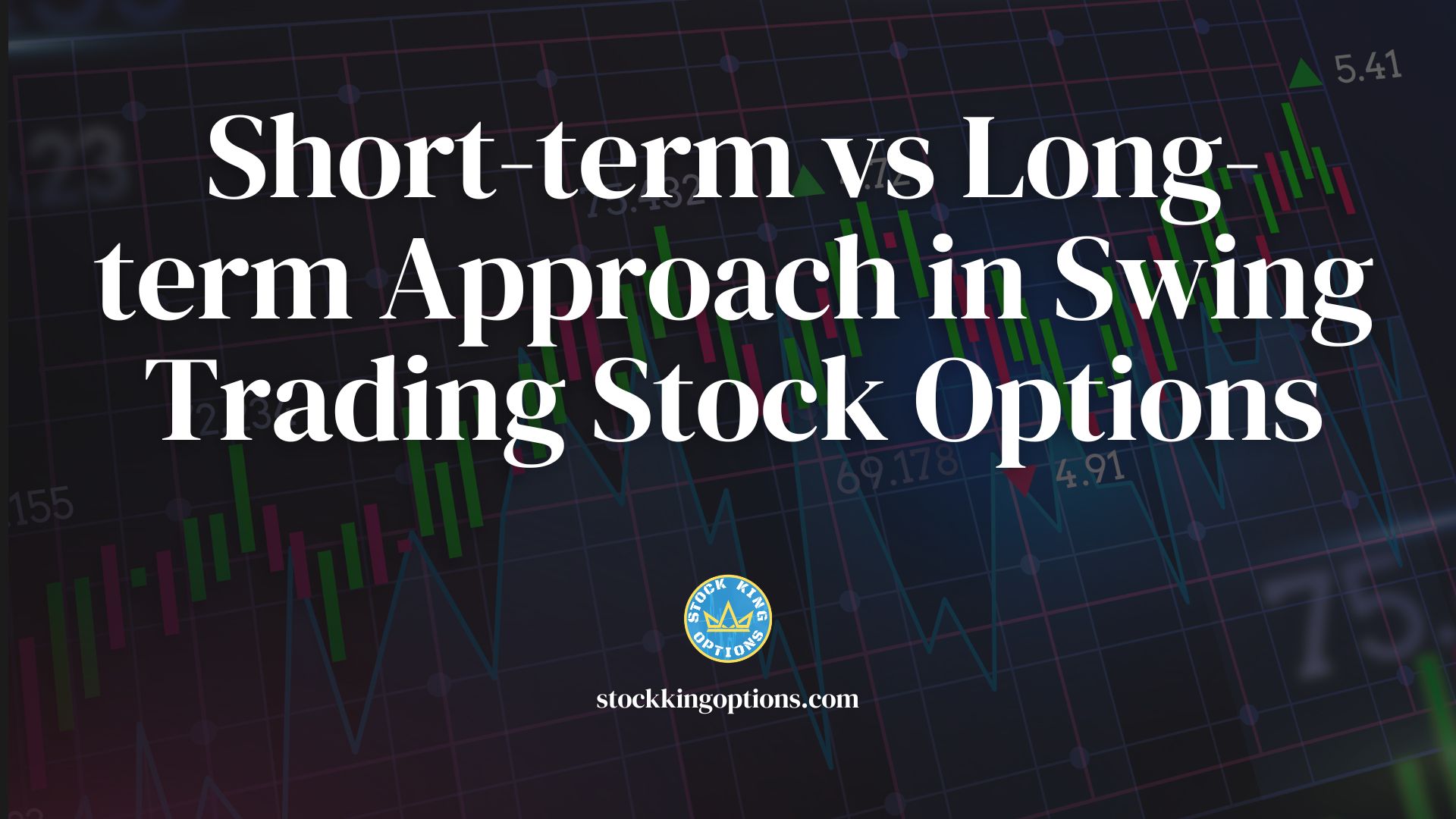
Key Takeaways:
– Choosing between a short-term and long-term approach is a critical decision in swing trading options.
– Short-term strategies focus on exploiting immediate market movements, while long-term strategies aim for sustained growth.
– Understanding the pros and cons of each approach is essential for aligning trading goals with the appropriate strategy.
Featured Snippet:
Question: What are the differences between short-term and long-term approaches in swing trading options?
Answer: Short-term strategies prioritize quick gains from short-lived market movements, while long-term strategies focus on sustained growth over an extended period. Understanding these distinctions is crucial for selecting the most suitable approach based on trading objectives.
Introduction:
In the realm of swing trading options, the choice between a short-term and long-term approach can significantly impact trading outcomes. This article examines the differences between these two strategies, providing insights into their respective advantages and considerations. By understanding the distinct characteristics of each approach, traders can make informed decisions aligned with their trading goals and risk tolerance levels.
Short-term Trading
Short-term trading, also known as day trading, is a popular approach in the world of swing trading stock options. As the name suggests, this strategy involves buying and selling stocks within a short period of time, typically within a single day or a few days. This is in contrast to long-term trading where investors hold onto their stocks for months or even years.
One of the main advantages of short-term trading is the potential for quick profits. Since trades are made on a daily basis, traders have the opportunity to capitalize on small price movements and make multiple trades in a single day. This can result in significant gains if done successfully.
Another benefit of short-term trading is that it allows traders to react quickly to market changes. In swing trading stock options, prices can fluctuate rapidly and being able to enter and exit positions swiftly can be advantageous. Short-term traders often use technical analysis tools such as charts and indicators to identify trends and make informed decisions about when to buy or sell.
In addition, short-term trading requires less capital compared to long-term strategies. With quick turnovers and smaller positions, traders do not need large amounts of money upfront to get started. This makes it an attractive option for those who may not have substantial funds but still want to invest in the stock market.
However, short-term trading also has its disadvantages. One major drawback is that it carries higher risks compared to long-term investing. Since trades are made based on short term price movements rather than the fundamental value of a company’s stock, there is always the possibility of losses if market conditions change suddenly.
Moreover, day trading requires dedication and discipline as traders must constantly monitor their positions throughout the day and be ready to act quickly when necessary. It can be mentally and emotionally taxing as well since losses can happen more frequently with this approach.
Another important consideration for short-term traders is transaction costs such as commissions which can add up over time with frequent trades. Therefore, it is crucial to take these fees into account when calculating potential profits.
Short-term trading can be a lucrative strategy for swing traders who are willing to take on higher risks and put in the effort to constantly monitor market conditions. It offers the potential for quick gains but also requires careful planning and risk management. Depending on an individual’s financial goals and risk tolerance, short-term trading may or may not be the right approach for swing trading stock options.
Long-term Investing
Long-term investing is a strategy that involves holding onto investments for an extended period of time, typically years or even decades. This approach is often favored by more conservative investors who are looking to build their wealth over the long run. Unlike short-term trading, which focuses on quick profits, long-term investing takes a more patient and calculated approach.
One of the primary benefits of long-term investing is the potential for higher returns. While short-term traders may be able to make quick gains in the market, they also face a higher level of risk. Long-term investors, on the other hand, have more time to ride out market fluctuations and can potentially see greater returns as they allow their investments to grow over time.
Another advantage of long-term investing is reduced transaction costs. When it comes to buying and selling stocks or options, there are fees associated with each trade that can add up over time. By taking a long-term approach, investors can minimize these costs and keep more of their earnings.
In addition to financial advantages, long-term investing also allows individuals to take a more hands-off approach. It requires less day-to-day monitoring and decision-making compared to short-term trading strategies. This means that investors can spend less time actively managing their portfolio and have more time for other pursuits.
When it comes to swing trading stock options specifically, there are some unique considerations for those taking a long-term approach. One key factor is understanding the expiration dates of option contracts. Unlike stocks that can be held indefinitely, options have expiration dates that must be navigated carefully when considering a long-term investment strategy.
Furthermore, it’s important for long-term investors in swing trading stock options to thoroughly research and understand the underlying company before making any investment decisions. Companies with strong financials and growth potential are better suited for this approach as they are likely to continue performing well over an extended period.
It’s worth noting that while long-term investing may offer many benefits, it also requires discipline and patience. It’s important to not get swayed by short-term market fluctuations and stick to a long-term plan, even in times of volatility.
Long-term investing can be a profitable and low-risk strategy for swing trading stock options. It allows investors to potentially see higher returns, reduce transaction costs, take a more hands-off approach, and make informed decisions about company fundamentals. However, it is important to have a well-researched plan and the discipline to stick with it for the best chance of success in the long run.
Finding the Right Balance
Swing trading stock options involves making short-term trades with the goal of taking advantage of market fluctuations and earning quick profits. However, there is another approach to swing trading that involves a more long-term perspective. In this section, we will discuss the importance of finding the right balance between these two approaches for successful swing trading in stock options.
Short-term strategies are focused on taking advantage of short-lived opportunities in the market. This can be achieved by carefully timing entries and exits, frequently monitoring market conditions, and using technical analysis tools to predict price movements. The main advantage of a short-term approach is the potential for quick profits. However, it also requires constant attention to the markets and can be mentally and emotionally demanding.
On the other hand, a long-term approach in swing trading involves holding positions for a longer period, usually several weeks or months. Traders who adopt this strategy tend to rely more on fundamental analysis rather than technical analysis as their primary decision-making tool. Long-term traders look at broader economic trends, company financials, industry news, and other macroeconomic factors that could affect a stock’s performance over time.
One of the key benefits of a long-term approach is reduced stress levels as traders do not have to constantly monitor their positions or make frequent trades. It also allows for a bigger picture view of the market and reduces reactive decision-making based on short-term fluctuations.
So which approach is better? The truth is that both have their own advantages and disadvantages depening on your learning curve. Short-term trading offers quicker returns but comes with higher risk due to rapid changes in prices in an unpredictable market environment. On the other hand, long-term trading has lower risk but requires patience as profitability may take longer periods to materialize.
The key here is finding a balance between these two strategies that works best for you as an individual trader. This should be based on your personal goals, risk tolerance level, available time commitment, financial resources, and experience in trading. Some traders may find that a mix of both short-term and long-term approaches is the ideal balance for them.
In addition to finding the right balance between these two strategies, it is also essential to have a well-defined trading plan and stick to it consistently. This includes setting clear entry and exit points, managing risk through position sizing, and continuously monitoring and adjusting one’s strategy based on market conditions.
The right approach for swing trading stock options will ultimately depend on your individual preferences and circumstances. Understanding the advantages and risks associated with each approach can help you make an informed decision while finding a balance between short-term gains and long-term profitability. Remember to always remain disciplined in your approach, plan your trades carefully, and continuously educate yourself on new strategies to improve your overall performance as a swing trader.




